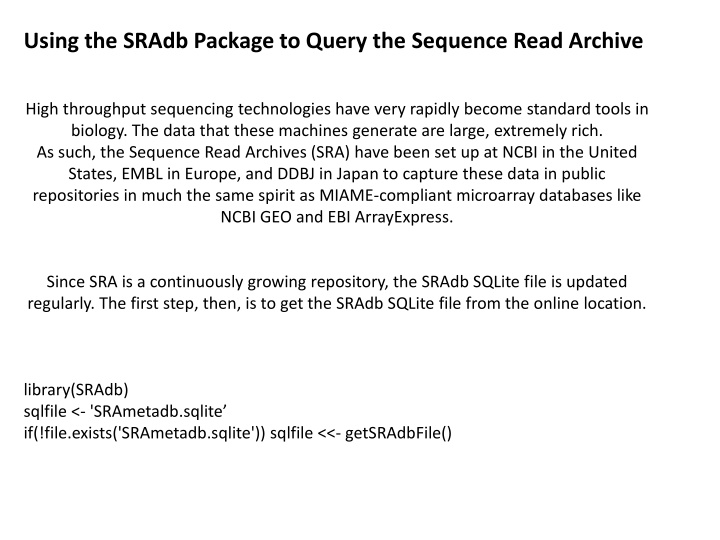
Querying Sequence Read Archive with SRAdb Package
Learn how to utilize the SRAdb package to query the Sequence Read Archive for high-throughput sequencing data. Understand the process of connecting to databases, listing tables and fields, accessing table schemas, and executing queries to retrieve results efficiently. Explore the capabilities of SRAdb SQLite file for accessing valuable biological data.
Download Presentation

Please find below an Image/Link to download the presentation.
The content on the website is provided AS IS for your information and personal use only. It may not be sold, licensed, or shared on other websites without obtaining consent from the author. If you encounter any issues during the download, it is possible that the publisher has removed the file from their server.
You are allowed to download the files provided on this website for personal or commercial use, subject to the condition that they are used lawfully. All files are the property of their respective owners.
The content on the website is provided AS IS for your information and personal use only. It may not be sold, licensed, or shared on other websites without obtaining consent from the author.
E N D
Presentation Transcript
Using the SRAdb Package to Query the Sequence Read Archive High throughput sequencing technologies have very rapidly become standard tools in biology. The data that these machines generate are large, extremely rich. As such, the Sequence Read Archives (SRA) have been set up at NCBI in the United States, EMBL in Europe, and DDBJ in Japan to capture these data in public repositories in much the same spirit as MIAME-compliant microarray databases like NCBI GEO and EBI ArrayExpress. Since SRA is a continuously growing repository, the SRAdb SQLite file is updated regularly. The first step, then, is to get the SRAdb SQLite file from the online location. library(SRAdb) sqlfile <- 'SRAmetadb.sqlite if(!file.exists('SRAmetadb.sqlite')) sqlfile <<- getSRAdbFile()
Using the SRAdb Package to Query the Sequence Read Archive High throughput sequencing technologies have very rapidly become standard tools in biology. The data that these machines generate are large, extremely rich. As such, the Sequence Read Archives (SRA) have been set up at NCBI in the United States, EMBL in Europe, and DDBJ in Japan to capture these data in public repositories in much the same spirit as MIAME-compliant microarray databases like NCBI GEO and EBI ArrayExpress. Since SRA is a continuously growing repository, the SRAdb SQLite file is updated regularly. The first step, then, is to get the SRAdb SQLite file from the online location. library(SRAdb) sqlfile <- 'SRAmetadb.sqlite if(!file.exists('SRAmetadb.sqlite')) sqlfile <<- getSRAdbFile()
Using the SRAdb Package to Query the Sequence Read Archive The function dbConnect {DBI} Connect to a DBMS going through the appropriate authorization procedure. sra_con <- dbConnect(SQLite(),sqlfile) The dbListTables function lists all the tables in the SQLite database handled by the connection object sra_con created in the previous section. sra_tables <- dbListTables(sra_con) There is also the dbListFields function that can list database fields associated with a table. > dbListFields(sra_con,"study")
Using the SRAdb Package to Query the Sequence Read Archive Sometimes it is useful to get the actual SQL schema associated with a table. Here, we get the table schema for the study table: > dbGetQuery(sra_con,'PRAGMA TABLE_INFO(study)') The table col desc contains information of filed name, type, descritption and default values: > colDesc <- colDescriptions(sra_con=sra_con)
Send query, retrieve results and then clear result set. dbGetQuery comes with a default implementation that calls: dbSendQuery {DBI} dbHasCompleted {DBI} dbFetch {DBI} dbClearResult {DBI} Requires a DBIConnection object, as produced by dbConnect and a character vector of length 1 containing SQL statement. rs <- dbGetQuery(sra_con,"select * from study limit 3") Get some high-level statistics could be to helpful to get overall idea about what data are availble in the SRA database. List all study types and number of studies contained for each of the type: rs <- dbGetQuery(sra_con, paste( "SELECT study_type AS StudyType, count( * ) AS Number FROM `study` GROUP BY study_type order by Number DESC ", sep=""))
Conversion of SRA entity types A graphical representation (sometimes called an Entity-Relationship Diagram) of the relationships between the main tables in the SRAdb package. Function sraConvert does the conversion with a very fast mapping between entity types.
